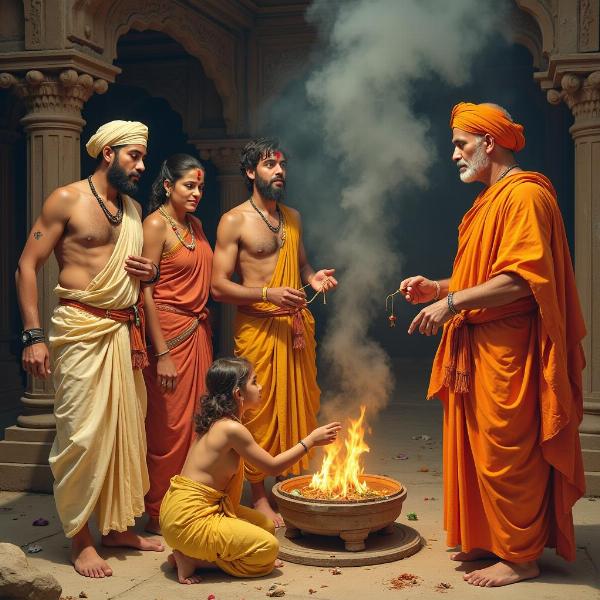Sanskritization, meaning in Hindi संस्कृतिकरण (saṃskṛtīkaraṇ), refers to the process by which lower castes adopt the customs, rituals, beliefs, ideology, and lifestyle of the upper, typically twice-born (dvija) castes, often Brahmins. This cultural shift aims for upward social mobility and enhanced social status. Understanding sanskritization meaning in Hindi involves delving into its historical context, social implications, and ongoing relevance in modern India.
What Does Sanskritization Entail?
Sanskritization encompasses a wide range of practices, from adopting vegetarianism and teetotalism to performing Vedic rituals and learning Sanskrit. It’s a complex process driven by the desire for social acceptance and improved standing within the hierarchical caste system. The adoption of upper-caste practices is seen as a way to emulate their perceived purity and prestige.
 Sanskritization Rituals
Sanskritization Rituals
Historical Context and Evolution of Sanskritization
The concept of sanskritization was popularized by M.N. Srinivas in the 1950s. His studies highlighted how lower castes sought to elevate their social status through emulating upper-caste practices. Historically, this process often involved adopting specific religious practices, dietary habits, and even changing surnames to reflect a higher caste affiliation.
Sanskritization and Social Mobility: A Pathway to Upward Movement?
While sanskritization aims for upward mobility, its effectiveness is debated. While it can lead to improved social standing within a local context, it doesn’t necessarily guarantee complete acceptance by the upper castes. Furthermore, the process can also create internal tensions within the lower castes, as some members may resist the abandonment of their traditional practices.
Sanskritization in Modern India: Relevance and Challenges
Even in contemporary India, sanskritization continues to play a role, albeit in evolving forms. With increasing urbanization and education, the focus has shifted somewhat from purely ritualistic adoption to embracing broader aspects of upper-caste lifestyles, such as education, professional careers, and consumerism.
The Role of Religion in Sanskritization
Religion forms a core component of sanskritization. The adoption of upper-caste religious practices, often involving Vedic rituals and Sanskritic texts, signifies a conscious effort to align with the dominant religious paradigm and claim a higher spiritual status.
Criticisms and Limitations of Sanskritization
While sanskritization can offer a path to social improvement, it’s crucial to acknowledge its limitations. Critics argue that it reinforces the existing caste hierarchy and can lead to the erosion of unique cultural identities within lower caste communities.
Conclusion: Sanskritization Meaning in Hindi – A Dynamic Cultural Process
Sanskritization, meaning in Hindi संस्कृतिकरण (saṃskṛtīkaraṇ), is a dynamic and complex process that continues to shape social dynamics in India. While its effectiveness in achieving complete social mobility is debatable, its influence on cultural change and the aspirations of lower castes remains significant. Understanding its nuances is essential for comprehending the complexities of Indian society.
FAQ
- What is the literal meaning of sanskritization? It literally translates to “becoming Sanskritized,” referring to the adoption of practices associated with Sanskrit culture, often linked to upper castes.
- Who coined the term sanskritization? M.N. Srinivas, a prominent Indian sociologist, introduced the term and concept in his anthropological studies.
- Is sanskritization still relevant today? Yes, although its manifestations have evolved, it continues to influence social aspirations and cultural practices in India.
- What are the main criticisms of sanskritization? It can reinforce caste hierarchies and lead to the loss of unique cultural identities within lower caste communities.
- Does sanskritization guarantee upward mobility? While it can contribute to improved social standing, it doesn’t necessarily guarantee full acceptance into upper-caste groups.
- What are some examples of sanskritization? Adopting vegetarianism, performing Vedic rituals, learning Sanskrit, and changing surnames are some examples.
- How does sanskritization relate to religion? Religion plays a central role, as adopting upper-caste religious practices is a key aspect of sanskritization.
Meaning-Hindi.in specializes in accurate and culturally sensitive Hindi translation services, covering a wide range of domains, from business and legal documents to educational and technical materials. Our expertise in Hindi language and culture ensures that your translations are not only linguistically precise but also culturally appropriate. Whether you need website localization or certified translation, our team of expert linguists can provide tailored solutions to meet your specific requirements. Contact us today for all your Hindi translation needs at [email protected] or call us at +91 11-4502-7584. Meaning-Hindi.in is your trusted partner for all your Hindi language solutions.